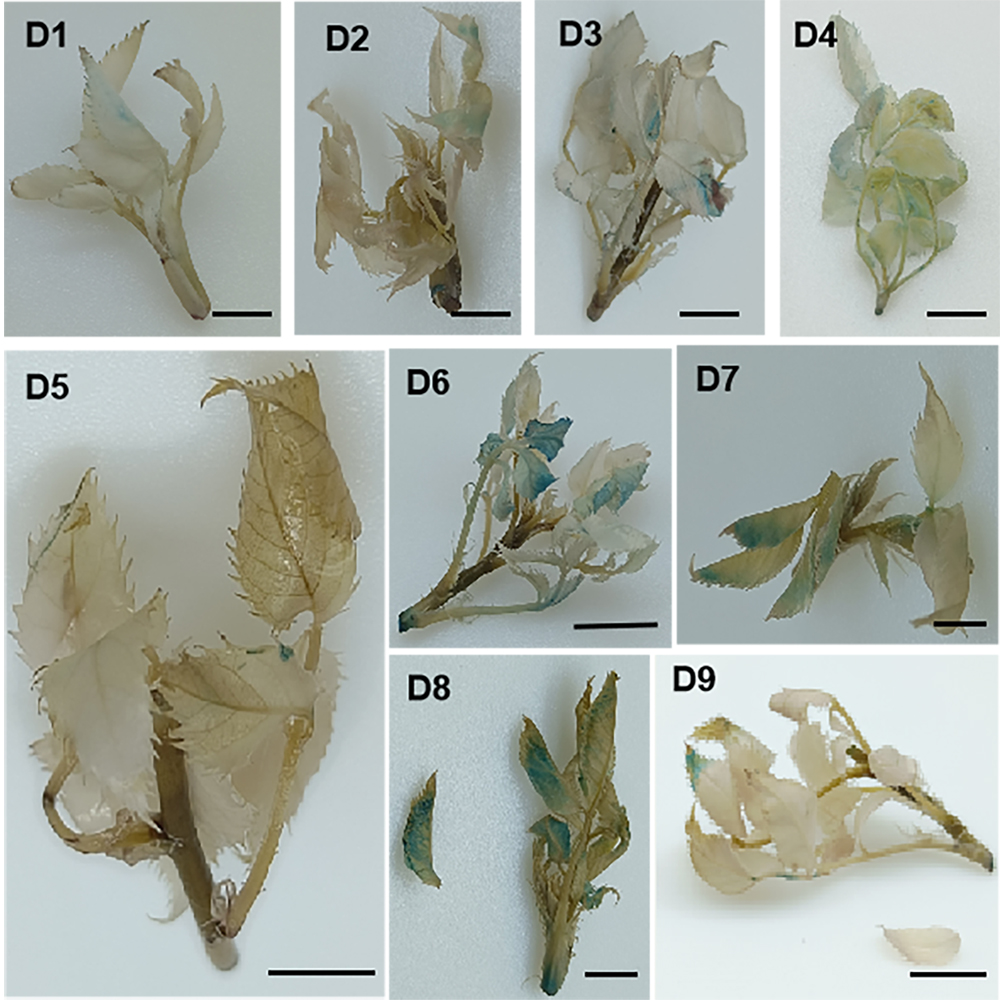

野蔷薇组培快繁和高效瞬时表达体系的建立
†共同第一作者
收稿日期: 2024-04-24
录用日期: 2024-08-20
网络出版日期: 2024-08-22
基金资助
国家自然科学基金(32072617);河北省自然科学基金(C2021105002);河北省现代农业产业技术体系建设专项(HBCT2024200405)
Tissue Culture, Rapid Propagation and Efficient Transient Expression Systems of Rosa multiflora
†These authors contributed equally to this paper
Received date: 2024-04-24
Accepted date: 2024-08-20
Online published: 2024-08-22
以野蔷薇(Rosa multiflora)当年生带芽茎段为试材, 建立了其组培快繁体系。结果表明, 最佳外植体是带腋芽茎段, 外植体最佳消毒方法是先用75%乙醇浸泡30秒, 再用10%次氯酸钠溶液浸泡20分钟, 成活率可达96%; 带芽茎段萌芽最佳诱导培养基为MS+1.0 mg∙L-1 6-BA+0.01 mg∙L-1 NAA+0.1 mg∙L-1 GA3, 培养30天, 萌芽率可达98%; 无菌再生苗增殖最佳基础培养基为WPM, 增殖系数为2.87; 无菌再生苗生根最佳培养基为1/2MS+1.0 mg∙L-1 6-BA+0.1 mg∙L-1 NAA, 生根率可达93%; 无菌再生苗移栽成活率达98%。在此基础上, 以野蔷薇无菌再生苗为受体, 建立了野蔷薇瞬时表达体系。结果表明, 瞬时表达最佳转化条件是菌液OD600为0.8, 负压为-0.10 MPa, 真空抽吸2次, 每次15分钟, 瞬时表达效率可达96%。研究结果为建立野蔷薇再生及遗传转化体系奠定了基础, 并为蔷薇属植物基因功能研究提供技术支持。

曹雪敏 , 包颖 , 张悦新 , 李瑞杰 , 苏健馨 , 张蔚 . 野蔷薇组培快繁和高效瞬时表达体系的建立[J]. 植物学报, 2025 , 60(2) : 235 -245 . DOI: 10.11983/CBB24061
A rapid propagation system via tissue culture for Rosa multiflora was established using the stem segments with buds of the current-year as the experimental material. The results showed that the best explants were stem segments with axillary buds. The best disinfection method was to soak the explants in 75% ethanol for 30 seconds, and then soak them in 10% sodium hypochlorite solution for 20 minutes. The survival rate can reach 96%. The optimal bud-induction medium was MS+1.0 mg∙L-1 6-BA+0.01 mg∙L-1 NAA+0.1 mg∙L-1 GA3. The budding rate can reach 98% after 30 days of cultivation. WPM was the best basal medium for the proliferation of sterile regenerated plantlets, and the proliferation coefficient was 2.87. The best medium for rooting was 1/2MS+1.0 mg∙L-1 6-BA+0.1 mg∙L-1 NAA, and the rooting rate can reach 93%. The transplanting survival rate of sterile regenerated plantlets was 98%. On this basis, the transient expression system of R. multiflora was established. The results showed that the optimal transformation conditions for transient expression were OD600 of 0.8 for the bacterium culture medium, vacuum negative pressure of -0.10 MPa and vacuum suction twice for 15 minutes each time. The transient expression efficiency can reach 96%. The results of this study laid a foundation for the establishment of regeneration and genetic transformation system of R. multiflora, and also provided technical support for studying on the gene function of Rosa plants.

| [1] | 丁萌 (2012). 野蔷薇再生体系的建立及其遗传转化的研究. 硕士论文. 武汉: 华中农业大学. pp. 14-38. |
| [2] | 龚维红 (2022). 大马士革玫瑰组培与快繁技术研究. 安徽农学通报 28, 19-21. |
| [3] | 李刚, 宋平丽, 王翔, 马青翠, 张海霞, 张玉星, 许建锋, 亓宝秀 (2021). 农杆菌介导的杜梨叶片瞬时转化方法的建立. 果树学报 38, 2006-2013. |
| [4] | 李惠玲, 罗玉兰, 章漳, 尹丽娟, 李圃锦, 张冬梅 (2020). 细梗蔷薇种子发芽及组织培养技术研究. 中国农学通报 36 (13), 89-93. |
| [5] | 李佳慧, 叶维雁, 朱鹏锦, 庞新华, 张继, 唐毓玮, 韦俏宇 (2022). 猫须草无菌短枝组织培养与快速繁殖体系的建立. 热带作物学报 43, 2063-2070. |
| [6] | 李静, 陈敏, 刘现伟, 沈法富, 王鹏 (2006). 莴苣高效瞬时表达体系的建立. 园艺学报 33, 405-407. |
| [7] | 李晓亮, 张军云, 张钟, 董春富, 杨世先, 王文智, 张建康, 张翠萍 (2017). 滇红食用玫瑰生根培养基的试验筛选研究. 西南农业学报 30, 656-663. |
| [8] | 李心悦, 张克闯, 张道远, 李进, 王玉成 (2018). 新疆野苹果瞬时遗传转化方法建立及初步验证. 分子植物育种 16, 7315-7321. |
| [9] | 李增武, 钟玲, 赵梁军 (2011). 野蔷薇种子休眠和萌发整齐度研究. 种子 30(10), 42-44. |
| [10] | 刘雪梅, 王蕾, 文添龙, 何鹏, 俞嘉宁 (2014). 农杆菌介导的棉花子叶瞬时表达系统的建立. 植物学报 49, 587-594. |
| [11] | 刘亚娟, 杨小艳, 谢树章, 吴红, 高立均 (2018). 芳纯月季组培快繁技术研究. 西南师范大学学报(自然科学版) 43(8),52-56. |
| [12] | 鲁艺, 史文君, 黄淑丹, 肖明 (2022). 苦水玫瑰组培快繁技术研究. 青海大学学报 40(3), 41-46. |
| [13] | 穆建鑫 (2021). ‘中梨一号’梨再生体系建立及秋子梨遗传转化体系探索. 硕士论文. 南京: 南京农业大学. pp. 13-24. |
| [14] | 彭奎莉, 孟繁博, 周志达, 郑关任, 张金柱, 杨涛, 车代弟 (2018). 不同基因型丰花月季快繁体系差异的研究. 见:张启翔. 中国观赏园艺研究进展2018. 北京: 中国林业出版社. pp. 480-486. |
| [15] | 强泽宇 (2015). 中华金叶榆繁殖技术研究. 硕士论文. 保定: 河北农业大学. pp. 6-12. |
| [16] | 任菲宏, 王姣, 李晓松, 石丽姝, 任红艳, 吴茂宏 (2023). 外植体取样时间和消毒方式对沙子空心李诱导培养的影响. 现代农业科技 (12), 77-79. |
| [17] | 宋常美, 文晓鹏 (2015). 4种贵州樱桃的高效离体再生. 西南大学学报(自然科学版) 37(9),19-24. |
| [18] | 王悦, 吴艳菊, 孟大伟, 郎晨婧, 赖薪宇, 刘佳, 葛禹凡, 杨丽萍 (2020). 植物瞬时表达体系真空侵染法的优化. 分子植物育种 18, 6743-6748. |
| [19] | 徐立军, 李志斌, 蒋淑磊, 李振勤 (2015). 大马士革玫瑰组织培养技术研究. 河北林业科技 (2), 19-21. |
| [20] | 闫海霞, 蒋月喜, 黄昌艳, 邓杰玲, 何荆洲, 王晓国, 卜朝阳 (2016). 月季‘卡罗拉’的组培快繁技术. 热带作物学报 37, 1741-1746. |
| [21] | 闫允青, 姜桦韬, 谷超, 吴俊 (2017). ‘雪花梨’扩繁和叶片再生体系的建立. 南京农业大学学报 40, 68-75. |
| [22] | 杨丽萍, 许亚男, 刘雨晴, 孟大伟, 金太成 (2016). 利用根部真空侵染法在烟草中瞬时表达外源蛋白. 分子植物育种 14, 3385-3389. |
| [23] | 张燕红, 黄乐平, 周小云, 王冬梅 (2008). 农杆菌真空渗透法转化棉花花粉的初步研究. 棉花学报 20, 354-358. |
| [24] | 赵月玲, 王汉海, 程贯召, 杜延飞 (2001). 枣组织培养中外植体取材部位的比较研究. 潍坊学院学报 1(2), 53-54, 43. |
| [25] | 周玉洁, 韦雪芬, 申长青, 李焜钊, 孙朝辉, 黄久香 (2019). 濒危植物四药门花的组培快繁. 植物生理学报 55, 635-641. |
| [26] | Lu J, Bai MJ, Ren HR, Liu JY, Wang CQ (2017). An efficient transient expression system for gene function analysis in rose. Plant Methods 13, 116. |
| [27] | Nakamura N, Hirakawa H, Sato S, Otagaki S, Matsumoto S, Tabata S, Tanaka Y (2018). Genome structure of Rosa multiflora, a wild ancestor of cultivated roses. DNA Res 25, 113-121. |
| [28] | Zhang Y, Zhao MJ, Zhu W, Shi CM, Bao MZ, Zhang W (2021). Nonglandular prickle formation is associated with development and secondary metabolism-related genes in Rosa multiflora. Physiol Plant 173, 1147-1162. |
/
| 〈 |
|
〉 |